Summary
Polyaniline (PANI) as one of the conducting polymers focuses intensive research on both scientific and practical field. There are quite a lot of known hybrid materials of PANI and other polymer systems with various synthetic polymers, which results in blends with various properties. The presented research covers the blends of polyaniline with semisynthetic (carboxymethyl) cellulose (CMC). The system could lead to a new antielectrostatic material with interesting properties and seems to be applicable as an additive for packaging in both food and non-food industry. The final material was obtained using both protonated (HCl) and deprotonated form of polyaniline in its semi-oxidized form of leucoemeraldine. Blending consisted in obtaining of thin layer by slow evaporation of the solvent from a mixture of PANI and CMC. For the main investigation atomic force microscopy (AFM) in non-contact mode was used, which gave the topological information about the surface and also some structural information about the material.
The described process seems to be very interesting as a route for obtaining a new hybrid natural/synthetic material with very interesting properties and a potential for application.
Similar content being viewed by others
References
a) Weidlich C, Mangold K, Juttner K (2001) Synth Met 119:263 b) Nguyen T, Barisci N et all (2003) Synth Met 137:445 c) Triojanowicz M (2003) Microchim Acta 143:75 d) Duvail J, Retho P et all (2003) Synth Met 135:329 e) MacDiarmid AG, Science and Apllication of Conducting polymers, IOP Publication 1991
a) Cao Y, Smith P (1993) Synth Met 57:2514 b) Shannon K (1994) J Chem Soc Chem Commun 5:64
a) Anand J, Palaniappan S, Sathyanarayana DN (1998) Prog Polym Sci 23:996 b) Gospodinova N, Terlemezyan L (1998) Prog Polym Sci 23:1443 c) Syed AA, Dinesan MK (1991) Talanta 38:815
Laska J, Widlarz J (2003) Synth Met 135:261
a) Masahiko Okada (2002) Prog in Polym Sci 27:87 b) Doi Y, Fukuda K (Ed.) Biodegradable Plastics and Polymers; Elsevier 1994
a) Tomasik P, Schilling R (2004) Adv Carbohydr Chem Biochem 59:1 b) Crini G (2005) Prog in Polym Sci 30:38 c) Sashiwa H, Aiba S (2004) Prog Polym Sci 29:887
Toshima N, Yan H (1995) Bull Chem Soc Jpn 68:1056
Kowalski G (2003) PhD Dissertation; Cracow University of Technology
Magonov SN (1993) Appl Spectrosc Rev 28:1
a) Chi L, Li H, Zhang X, Fuchs H, Shen J (1998) Polym Bull 41:695 b) Lin HN, Hung TT, Chang EC, Chen SA (1999) Appl Phys Lett 74:2785 c) Wang Y, Song R, Li Y, Shen J (2003) Surf Sci 530:136
a) Pielichowski K, Pielichowski J, Iqbal J, Gurtat P (1997) Appl Catal A 167:L25 b) Pielichowski K, Hasik M (1997) Synth Met 89:199 c) Chan HSO, Ho PK (1989) Synth Met 31:95
Pielichowski K (1997) Solid State Ionics 104:123
Wunderlich B, Thermal Analysis. Academic Press, New York, 1990
Author information
Authors and Affiliations
Corresponding author
Rights and permissions
About this article
Cite this article
Lukasiewicz, M., Ptaszek, A., Koziel, L. et al. Carboxymethylcellulose/polyaniline blends. Synthesis and properties. Polym. Bull. 58, 281–288 (2007). https://doi.org/10.1007/s00289-006-0638-8
Received:
Revised:
Accepted:
Published:
Issue Date:
DOI: https://doi.org/10.1007/s00289-006-0638-8




